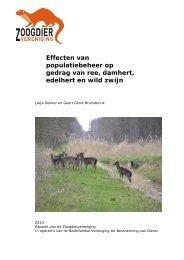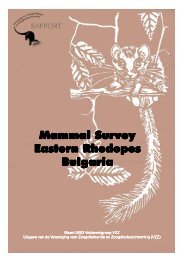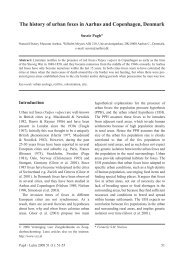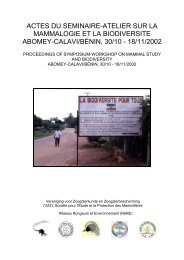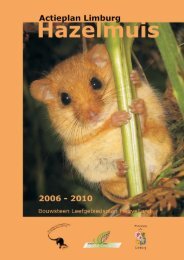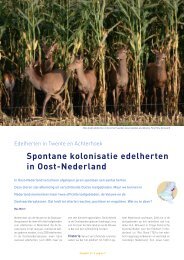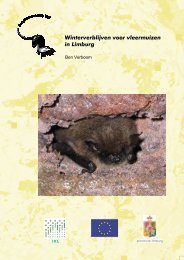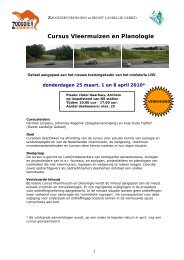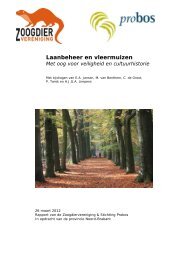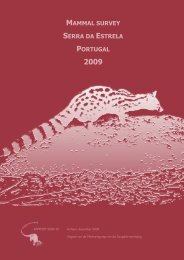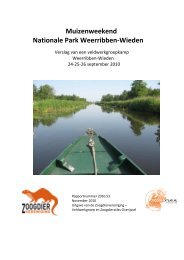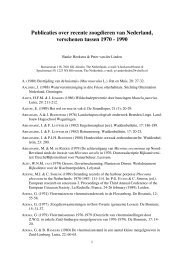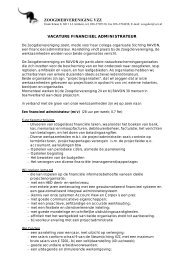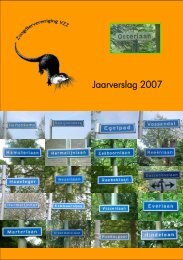Mammal survey Pol'ana - De Zoogdiervereniging
Mammal survey Pol'ana - De Zoogdiervereniging
Mammal survey Pol'ana - De Zoogdiervereniging
You also want an ePaper? Increase the reach of your titles
YUMPU automatically turns print PDFs into web optimized ePapers that Google loves.
4.4 TRACKS & TRACES by: Annemarie van Diepenbeek<br />
Not all mammal traces found during this workshop are mentioned here, only some relevant for the region or<br />
special types of traces are described.<br />
European European souslik souslik (Spermophilus (Spermophilus citellus)<br />
citellus)<br />
At different locations, for instance on a slope nearby our camp site in Látky, there were European souslik<br />
colonies. Except for the frequently used cave entrances, to be recognized by the small piles of soil before<br />
them, also many trap-pipes were found. These passages going down perpendicularly are used by European<br />
sousliks to dive underground in case of danger. They are all over the paths and differ from the normal cave<br />
entrances by the absence of moved soil. The diameter of the cave entrances as well as that of the escape<br />
pipes is usually 5–6 cm. The caves are connected through an extensive network of also 5–6 cm wide paths,<br />
that are clearly lightly coloured near the caves by the grains of sand that fell off the paws and furs. On the<br />
small piles of soil before the caves excrements can be found. They are solid in consistency and look like big<br />
rat droppings. With the adult animals these are 5–7 mm thick and 10–16 mm long (so, relatively big).<br />
Sometimes they are stuck together in oblong clusters. Every (mature) animal has its own cave entrance and<br />
produces numerous fresh droppings. When fresh they are dark green, but they discolor very quickly to black<br />
or blackish grey.<br />
Forest Forest dormouse dormouse (Dryomys (Dryomys (Dryomys nitedula) nitedula) nitedula) and and Common Common dormouse dormouse (Muscardinus (Muscardinus avellanarius)<br />
avellanarius)<br />
In the forest on the slope at Bratkovica on July 30th 2005, a number of nesting boxes were checked for<br />
rodents. Unfortunately (probably because of the very high temperature during the day) no animals were foud<br />
in these nesting boxes, but the inspection provided the opportunity to look at the nest form and the materials<br />
that were used. According to local biologists Forest Forest Forest dormice dormice mostly make a somewhat block like nest in these<br />
nesting boxes with a bowl-shaped hollowing (as in a tit nest). The material used was mostly moss<br />
(Sphagnum), leaves and hair. The nests of Hazel Hazel dormice dormice are mostly bulb-shaped and have an opening on<br />
the side. They are mostly constructed using leaves, grass and lichens.<br />
Roe Roe deer deer (Capreolus (Capreolus (Capreolus capreolus) capreolus)<br />
capreolus)<br />
A nice, but very rare trail type of the Roe deer is the so-called roe-ring. Two of those were found near to<br />
each other on a low slope on the edge of a foliage forest not far from the camp site (Novy Svet, August, 1st ).<br />
Such a track is formed during the rutting season. Sometimes it happens that a Roe deer-goat, whilst chased<br />
by a buck, is going in circles. The buck follows her in the same circles and that way a flattened circular or<br />
oval path develops in the vegetation. The dimension of the biggest of the two paths (here it was oval) was<br />
7.3 meters long and 4.7 meters wide. The width of the walking track was 40–45 cm.<br />
Brown Brown bear bear bear ( (Ursus ( Ursus arctos arctos) arctos<br />
The most striking trace of the Brown bear were the so-called scratching trees. While examining the bark of<br />
the tree more closely, not only scratching from nails was seen, but also heavy indentations caused by the<br />
canine teeth. A group of 6–7 (relatively small) scratched trees was discovered on July 30th 2005 in the forest<br />
on the slope near Bratkovica, a mixed forest with a border of firs. The bears use these trees not only for<br />
sharpening their nails, but also to rub their against it. Whether the bite marks only have a function of putting<br />
scent on it (=marking) or whether the bear is taking out his aggression on it, is not quite clear. (Almost two<br />
months later, on September 20th , 2005, Peter Kaňuch emailed that on this particular spot a mushroom picker<br />
was attacked by a bear that was not yet full-grown. Luckily he got away with only a few scratches).<br />
On August 4th, a very large pine with scratch- and bite marks was seen in the mixed wood at Pol’ana. There<br />
were also some “satellite trees”, that were also scratched, but less intensively. On a forest path in the<br />
neighbourhood a black and crumbly excrement was found that was spoiled by rain, which contained mostly<br />
rests of blue bilberry. On the largest tree the bite marks were on approximately 2 meters height and the nail<br />
scratches even up to 2.5 meters! The marking function was very obvious here. There was a lot of hair sticking<br />
in the resin running out at a height of approximately 1.70 m. The bear must have had a scratch there,<br />
standing on its hind legs with its shoulder against the tree. We would have liked to see this animal in<br />
“person” (on respectful distance of course)! The hairs of a bear of up to 17 cm long were relatively thin<br />
(summer fur), but very tough. Unfortunately no foot prints of the bear were seen.<br />
<strong>Mammal</strong> <strong>survey</strong> <strong>Pol'ana</strong> (Slovakia) 2005 27



